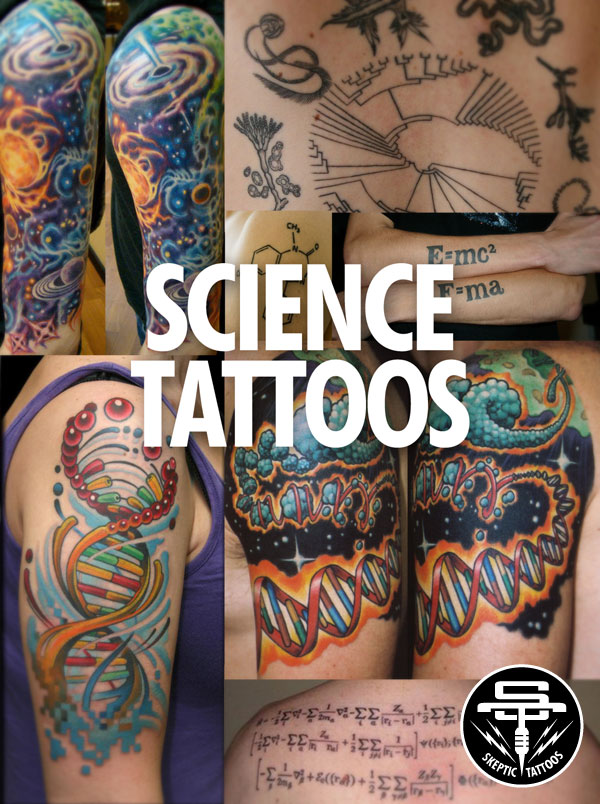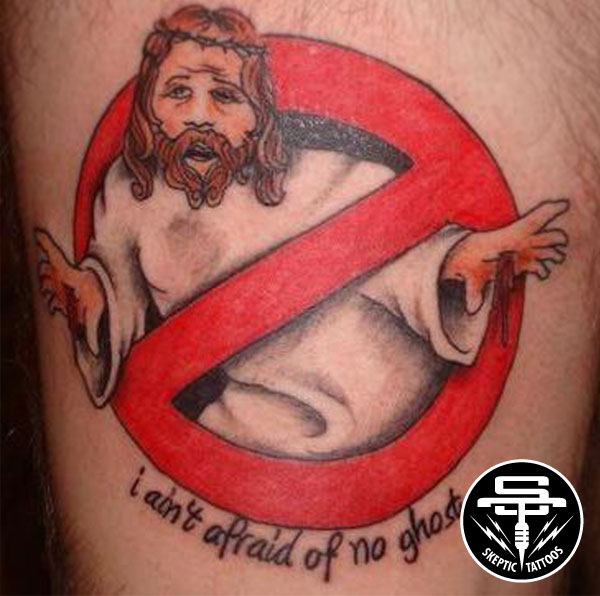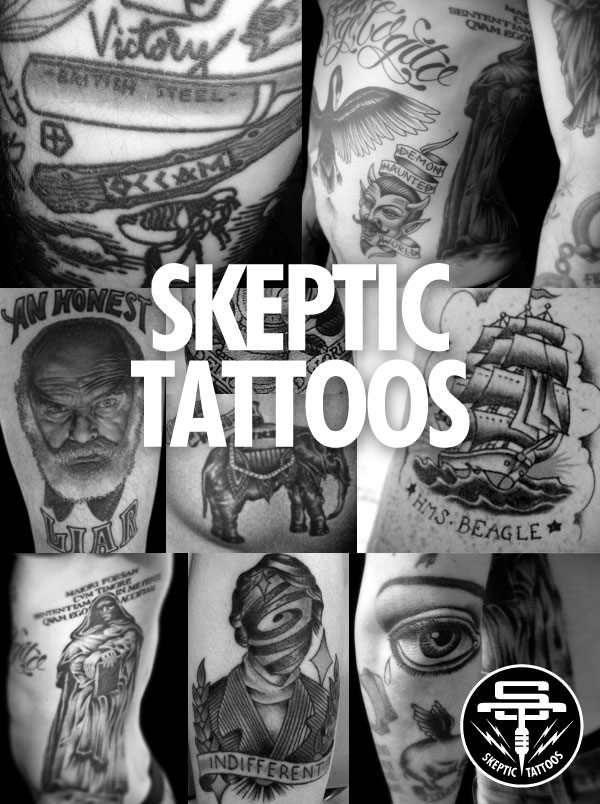In Search of a New Iconography
by Arlo Eisenberg
Sometime over ten years ago I decided that I wanted to get a Skeptical tattoo. I had a feeling in my mind of what I wanted, but there were no clear references to work from. I was aware that people were getting science tattoos, but those were not exactly what I was looking for.
I saw a lot of cosmological tattoos and tattoos of DNA and chemical structures and mathematical equations. Typically the “science tattoos” correlated directly with a particular area of study or expertise. A chemistry student might have a tattoo of some protein, for example, or a marine biologist might get a tattoo of a jellyfish.
Science tattoos are not exactly skeptic tattoos.
What I wanted was not just a science tattoo, but a skeptical tattoo. I am not a practicing scientist, I have no connection to any particular area of study, but I am a Skeptic; I apply the methods of science and reason to the investigation of all claims (or at the very least, I am a big fan of the people who do!). What I wanted was to honor the heroes and tenets of Skepticism, which in many ways would be the same as honoring science (or scientists), but Skepticism celebrates the entire enterprise of science more than any particular area of study and there are figures from science and history that have played prominent roles in the history of Skepticism specifically.
Furthermore, and this is important, I wanted to be in control of the message. A science tattoo is (and looks) exactly like what it sounds like, a science tattoo. You don't have to know anything about DNA or physics or chemistry to know that a double helix or a mathematical equation or a chemical diagram looks like "science."
Atheist tattoos can be confrontational.
Atheist tattoos tend to be even more conspicuous. They are often aggressively antagonistic, sometimes lampooning Jesus and other religious icons. If science tattoos lack subtlety, then atheist tattoos could be said to also lack tact.
Atheist tattoos, like science tattoos, tend to be pretty unambiguous.
Atheism is not a part of the Skeptical doctrine, no more than it is a part of scientific doctrine. Skepticism and science merely provide the tools for investigating claims, they make no claims themselves. Skepticism and science both emphasize the process over the conclusions. While it is true that atheism can be a consequence of following the evidence wherever it may lead and adopting a naturalistic worldview, it is not a prerequisite to membership in either the Skeptical or scientific communities.
In either case, whether talking about science tattoos or atheist tattoos, the message usually tends to be pretty unambiguous, "oh, she is really into science," or, "oh my goodness, he hates god!"
When considering Skeptic tattoos I longed for a more artful approach. I wanted my tattoos to be engaging rather than alienating. I didn't want to be an activist every time I took my shirt off. I wanted people to be curious about my tattoos and possibly to even ask about them. I wanted them to look mysterious and important. I wanted them to look timeless.
Ironically, the closest examples to how I envisioned my Skeptic tattoos looking came from religious tattoos. Religious tattoos look important. They are imbued with meaning. Religious tattoos, and I am speaking mostly about Christian tattoos here, since that is what I have been exposed to the most in America, have a rich lexicon of iconography drawn from centuries of religious characters, symbols and stories.
Religious tattoos are imbued with meaning.
So, armed only with a vague idea of what I wanted and a slightly less vague idea of what I didn't want, I started to conceive of Skeptical tattoos. I mined the skeptical history and literature for characters, themes and ideas that could be turned into symbols or art that could provide secular alternatives to the rich religious iconography that was already so prevalent in tattoos.
Tattoo of Ockham's Razor.
My first Skeptic tattoo was of Ockham's razor. Also known as the principle of parsimony, Ockham's razor is one of the guiding principles of science and is a well established axiom within Skepticism (it was featured prominently in the movie Contact, starring Jodie Foster, and written by Carl Sagan). The tattoo was illustrated with a straight edge razor, itself timeless and slightly menacing, and embellished with a banner bearing the text of the principle of parsimony in Latin. Finally, this was what I'd always been looking for but could never find; an enigmatic tattoo inspired by science, based on a Skeptical theme, but that did not look like an advertisement for a worldview.
Now, over ten years in and dozens of tattoos later (and counting), I've decided to curate a site devoted to Skeptic tattoos, both to share my tattoos and to find what other skeptically themed tattoos may be out there. My hope is to continue building a library of Skeptical iconography that might provide a satisfying alternative for people like me, who feel a strong association with and appreciation for science and a naturalistic world view, but who have had trouble finding the perfect way to express it.






